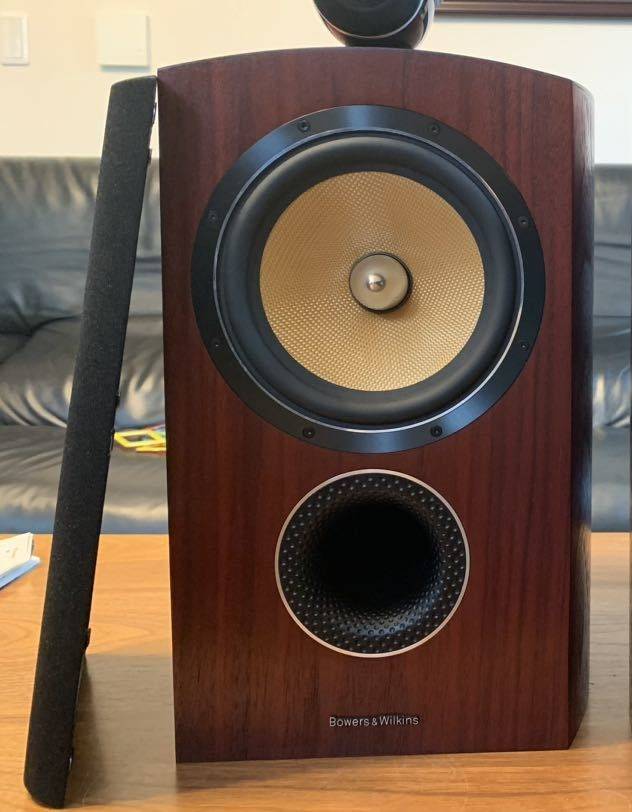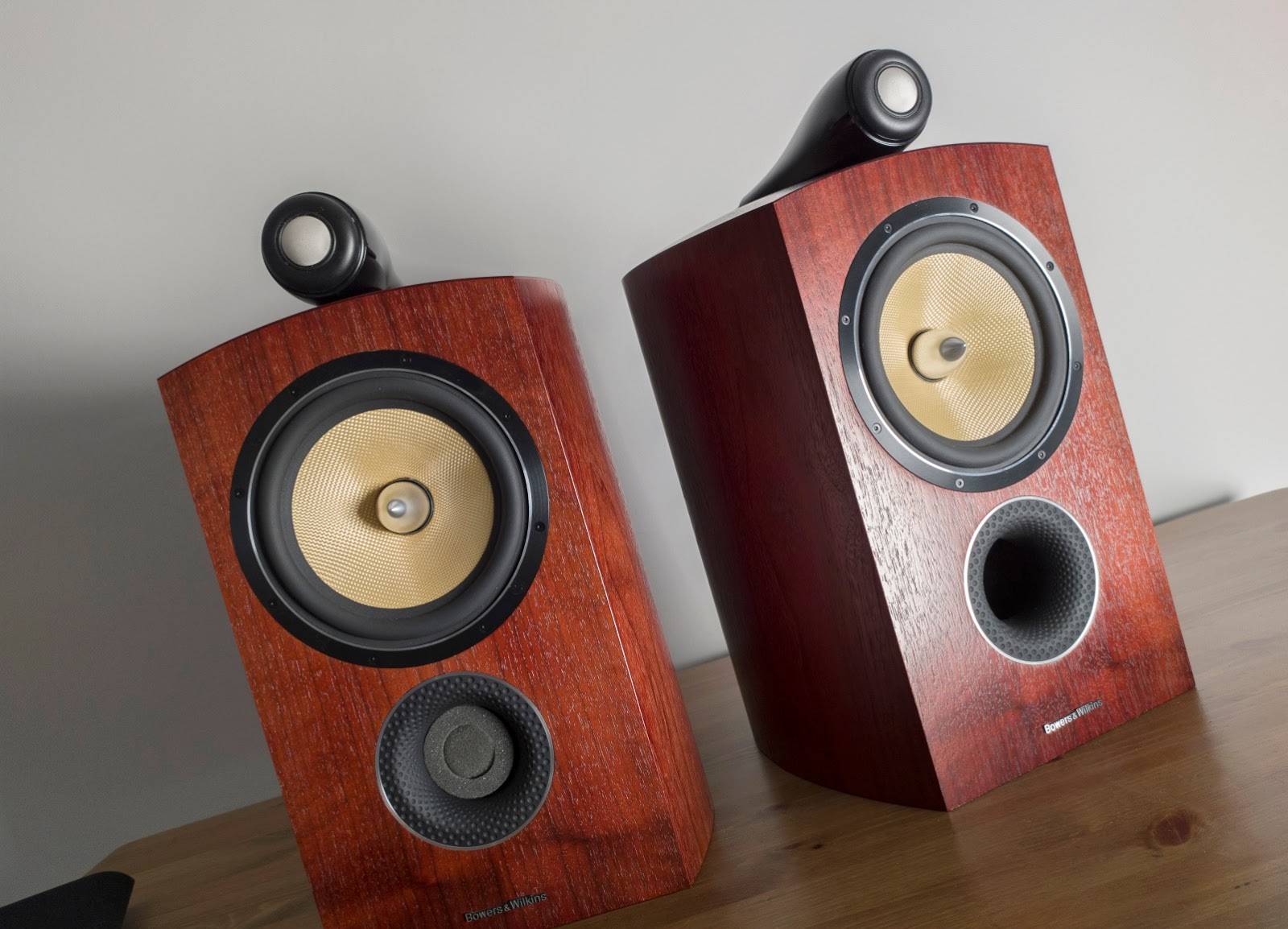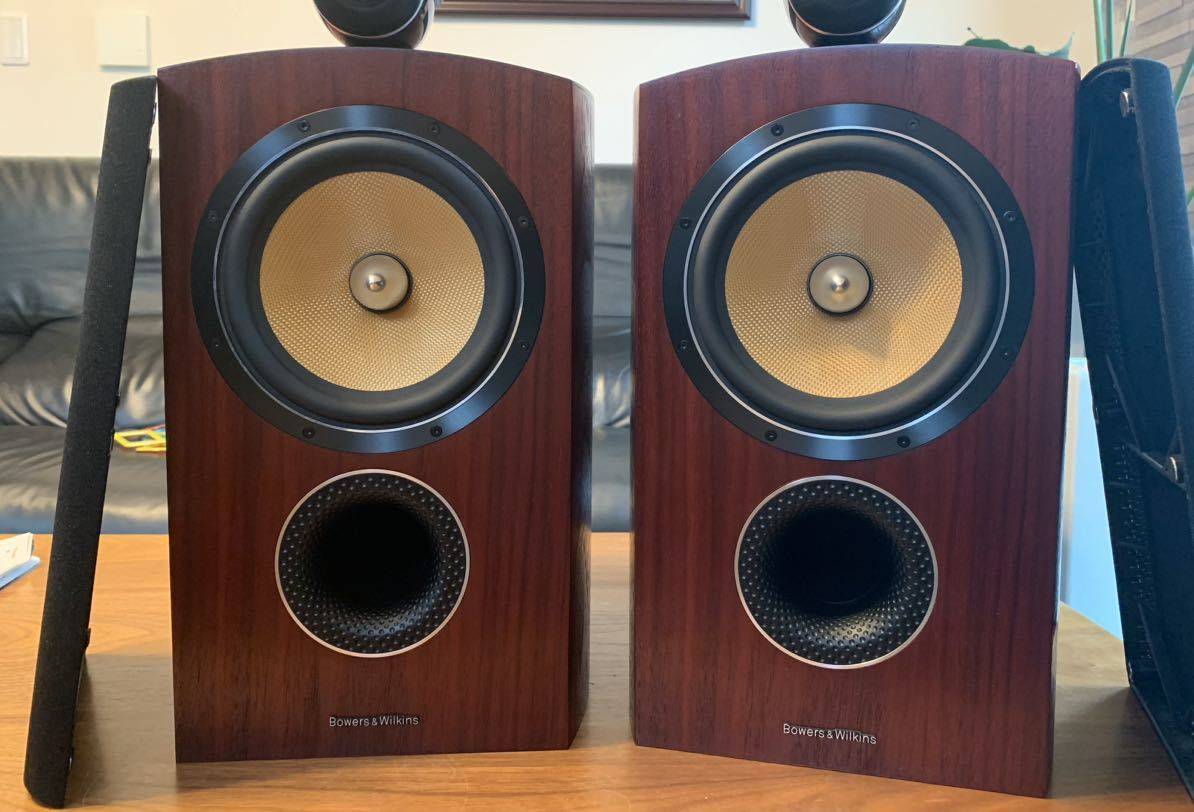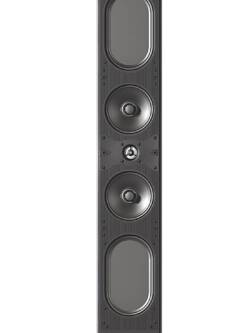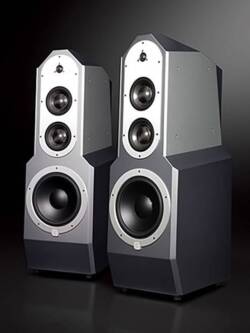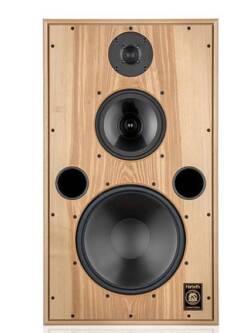B&W 805 Diamond Bookshelf Speakers (Rosewood)
Original price was: R210,000.00.R68,000.00Current price is: R68,000.00.
PECS & PRICING
Type: Two-way, vented-box system
Drivers: One 6.5” woven Kevlar mid/bass, one 1” diamond dome tweeter
Frequency response: 49Hz–28kHz (–3dB)
Sensitivity: 88dB (2.83V/1m)
Impedance: 8 ohms
Recommended amplifier power: 50W–120W into 8 ohms
Dimensions: 9.4” x 16.5” x 13.8”
Weight: 26 lbs. each
Warranty (parts and labor): Five years
Price: $5000 (pair) cherrywood, rosenut, piano black gloss, FS-805 stand: $700 (pair)
Description
The Bowers & Wilkins 800 Series of speakers has been among the most highly-regarded of its kind for over the past three decades. The 800 Series has not only whetted appetites the world over, but found homes in some of the most highly-regarded recording studios, including Abbey Road, where most of the Beatles’ and Pink Floyd’s albums were recorded. Thankfully, Bowers & Wilkins has not rested on its laurels. The 800 Series of today shares its roots and basic design with the 801, introduced in 1979, but features significant refinements that keeps this series among the world’s finest. Bowers & Wilkins’ Matrix bracing technology, Nautilus tapered tubes and yellow Kevlar midrange drivers carry on into the newest 800 Diamond series, introduced in 2010.
Additional Resources
• Read more bookshelf speaker reviews by the HomeTheaterReview.com writers.
• Explore more reviews in our Subwoofer Review section.
• See more reviews in our Digital to Analog Converter Review section.
The 805 Diamond reviewed here is the smallest speaker in the current 800 series lineup, but it shares the same newly developed diamond tweeter that is found in the rest of the 800 Series. While diamond tweeters are not new to Bowers & Wilkins, the current 800 Series uses a newly designed one-inch dome diamond tweeter made by a chemical vapor deposition process that does not break up until 70kHz, much higher than rigid dome tweeters made from more traditional materials. With the range of human listening topping out at the 20 kHz range, one may argue the merits of increasing the breakup frequency from 30 or 40 kHz to70 kHz, but Bowers & Wilkins’ listening tests have found that the higher the breakup frequency, the cleaner the sound within hearing range. The diamond dome material is a large contributor to what provides the tweeter with the potential to perform well, but it is only part of the overall assembly and would be wasted if the rest of the assembly was not up to the task. Thankfully, the technological advancements of the tweeter assembly go beyond the diamond dome material. The tweeter uses a quad magnet design, a new surround and the Nautilus-inspired tapered tube, which is mechanically isolated from the speaker cabinet by a viscoelastic material. The magnet assembly and tapered tube design reduce compression, which in turn improves linearity.
The six-and-a-half-inch midrange/bass driver is made out of Bowers & Wilkins iconic yellow woven Kevlar, surrounded by a chrome trim ring that matches the chrome phase plug. The Kevlar driver material has developed over the years. The current Kevlar drivers are designed with just enough flexibility to decrease the radiation area as the frequency increases. This flexibility reduces the beaming effect (a narrow dispersion pattern) that would otherwise occur with a cone driver that was purely pistonic in its movement. The 805 Diamond breaks from the floor-standing speakers in the 800 Diamond Series as it does not have the FST surround on the midrange/bass driver. I expect that this is because the FST surround does not allow the extension necessary for the driver to cover the lower portion of the frequency range in this two-way design.
Just below the driver is the dimpled “Flowport,” with another chrome trim ring. While the Flowport is hardly a new design, the flared port, combined with golf ball-like dimpling, is effective in reducing port noise. A newly designed crossover design utilizes gold/silver/oil Mundorf capacitors in a simplified assembly said to improve tweeter clarity. The 805 Diamond is also bi-wire-capable through newly designed binding posts, with oxygen-free copper terminals that are as attractive as they are easy to use. If you do not plan on bi-wiring, the supplied jumpers are of high quality and should serve well. The 16.5-inch-tall cabinets are a little over nine inches wide at the front and have a graceful curve over their 13.8-inch depth that culminates in a rounded back. The top panel is also sloped and curved, leaving only the front and bottom panels flat. Despite their modest size, the speakers weigh in at 26 pounds each, due in no small part to the cabinets utilizing Bowers & Wilkins’ matrix bracing system and nearly one-and-a-half-inch-thick walls. Knocking on various parts of the cabinet resulted in well-muted thuds.
Bowers & Wilkins states that the 805 Diamonds have an efficiency rating of 88dB, a nominal impedance of eight ohms and a frequency response of 49 Hz to 28 kHz +/- 3 dB, with -6 dB points at 42 Hz and 33 kHz.
All of this technology does not come cheap. The Bowers & Wilkins 805 Diamonds are $5,000 per pair and their dedicated stands are available for another $700 per pair. My review samples came in a very attractive Cherrywood veneer, with a furniture-grade finish. Rosenut and Piano Black Gloss finishes are also available. While some may feel that $5,000 is an exorbitant amount of money for a pair of small stand-mounted speakers, it is a relatively small price for the technology and material one gets with the 805 Diamonds.
The Hookup
I had no problems unpacking and setting up the 805 Diamonds without an extra set of hands. I placed them on heavy metal stands that I have had around for a long time. While the stands are not marked with the name of the manufacturer or model, they look extremely similar to the Bowers & Wilkins stands and place the tweeters at ear level to my seated listening position. I connected the speakers with a single run of speaker cable to McIntosh Laboratories MC501 power amplifiers and C500 preamplifier. I used PS Audio’s PerfectWave MKII DAC with network bridge and PerfectWave Transport as source components (PerfectWave review forthcoming).
After a bit of experimentation, I ended up with the speakers about seven feet apart, a little more than three feet from the front wall, about two-and-a-half feet from the side walls and toed in directly to my listening position. The speakers took well over a hundred hours of break-in before they began to settle in and they probably continued to improve for another few weeks. The difference between out of the box and fully broken in was dramatic. Before you audition these speakers, be sure that they are fully broken in or you will not hear their full potential.
Read about the performance of the B&W 805 Diamond bookshelf on Page 2.
Performance
I first sat down to listen to the 805 Diamonds only a couple days after I received them. I remember thinking that treble sounded nowhere near as clean and detailed as the same tweeter in my 800 Diamonds. I continued to let the 805 Diamonds break in for another week or so. The improvement was not subtle. I did most of my listening after removing the main grille that covers the midrange driver. I left the small metal grille in place over the diamond tweeter, although both grilles are easy to remove, as they are held in place with magnets.
Most of my daily listening consists of rock, jazz and blues, but there are a few pieces of classical music that have been getting some routine play. With the PS Audio system, I have been able to play back Reference Recordings’ HRx format discs which feature 24bit /176.4 kHz WAV files. Nikolai Rimsky-Korsakov’s “Dance of the Tumblers from The Snow Maiden” off of the disc Exotic Dances from the Opera features bells that can be very lifelike, which they were on the 805 Diamonds. The bells can come off sounding a bit hollow or flat with less capable tweeters, but with the 805 Diamonds, they were dynamic. The tweeters were not only detailed enough to capture the tonal character of the bells, but also had the energy to make the bells jump out at you as they would in real life. The speakers disappeared in a large and very deep soundstage that seemed to go on well beyond the physical confines of my listening room. I was not expecting much in the way of bass, as I had been listening to the much larger 800 Diamonds and Legacy Signature SEs, but the diminutive 805 Diamonds provided usable bass done into the low 40Hz range allowing most drums to be well represented.
Staying with classical music, I listened to a couple different versions of the classical piece that has been getting the most play in my house, Carl Orff’s Carmina Burana. I played both the traditional version (Telarc, SACD/CD) and a modern interpretation of “O Fortuna” from Carmina Burana called “The Mass” by Era (Universal Records, CD). Both versions are very dynamic pieces that feature a choir, as well as an orchestra. As with the Rimsky-Korsakov piece, the soundstage was expansive. The instruments and vocalists were solidly placed, especially with the traditional Telarc version. Despite high listening levels, I had no problems with compression and the speakers showed no signs of congestion. However, in direct comparison to the Bowers & Wilkins 800 Diamonds and the Legacy Signature SEs, the smaller and less expensive 805 Diamonds gave up several things. The most noticeable were bass extension and impact. The 805 Diamonds do not at all suffer from the anemic mid-bass that plagues smaller or lesser stand-mounted speakers. Bass guitar and most drums were reproduced with convincing weight and slam. However, the single pair of six-and-a-half-inch drivers simply cannot provide the visceral impact, slam and depth that the larger speakers are capable of producing. The other difference I noticed was in midrange clarity, particularly in the upper midrange. While the 805 Diamonds are extremely capable, in direct comparison to the 800 Diamonds, the 805s seemed a bit softer and did not provide as much detail in the upper midrange. The effect of this was like trying to pick out faces in a crowd. The 805 Diamonds cast off enough metaphorical light to see well into the crowd, but not all the way to the back, whereas the 800 Diamonds shed that additional luminosity, letting you discern the individual elements even at a distance. Soundstage, image and the luscious treble were remarkably similar between the two speakers.
While I enjoyed listening to the 805 Diamonds unravel complex layers of the orchestras with undeniable musicality and sense of natural ease, I needed to turn up the beat a little. I cranked up Aerosmith’s “Love in an Elevator” off their Big Ones album (Geffen Records, CD) but it didn’t satisfy my craving for in-your-face rock. Neither did AC/DC’s Back in Black disc (Atlantic Records, CD). My friend Greg was over, listening with me, and we both thought that the guitars were a bit polite and did not have that gritty edge typical to the genre. I later swapped out the McIntosh amplifiers for my Nuforce V3 SEs and they pushed up the edgy and gritty quotient a bit, but the 805 Diamonds never sounded aggressive. They continue to share what some call the Bowers & Wilkins polite house sound.
The politeness should not be mistaken for being unrevealing or having a laid-back top end. I recently picked up a copy of David Guetta’s Nothing But the Beat (CD, Capitol Records) and we played the track “Titanium” that features Sia on vocals. While her voice was clear, powerful and balanced, the highs were harsh and glaring. We both attributed this to the recording, as the harshness was an anomaly from the rest of our listening experience. We tried another album from Nicki Minaj in the same genre (Minaj performed with David Guetta at the 2011 American Music Awards). The track “Super Bass” from the album Pink Friday (Universal, CD) did not show signs of the grating harshness found on the “Titanium” track. One thing I was concerned about before my listening sessions was bottoming out the midrange/bass drivers by playing bass heavy music at louder volumes. I need not have worried.
These last two albums are filled with deep synthesized bass. The 805 Diamonds held their own, given their size, but could never energize the room with the lowest frequencies without the help of a subwoofer. During the course of my listening, I would occasionally switch in Bowers & Wilkins’ DB-1 subwoofer. I set up the subwoofer off of a separate pre-amplifier output that did not alter the signal to the main speakers. With a little bit of tweaking of the crossover through Bowers & Wilkins SubApp program, I was able to achieve a good blend between the 805s and the DB-1. With most music, the DB-1 was unnecessary, as the 805s were more than capable of reproducing bass guitar and most drums without any aid. The DB-1 did come in handy by extending the lower end of the range to cover everything from the powerful synthesized bass tracks from today’s music to pipe organs and large drums. I would suspect that the 805/DB-1 combination would work just as well with movie explosions.
The Downside
The 805 Diamond is an extremely capable speaker within its operating range (everything except the lowest bass). The speaker does not do anything notably wrong. It cannot reproduce the lowest bass notes, but it plays cleanly as far down as it goes and never bottomed out or showed other signs of stress. If you want more bass from your main speakers, Bowers & Wilkins has either larger speakers or subwoofers as a proposed solution.
88 dB efficient speakers aren’t power pigs, but there are others in the category that are easier to drive. You will want to be sure to mate 805s with a capable power amp. These aren’t speakers that you power with an AV receiver.
It was hard to identify a “downside” with the 805 Diamonds, but some may not care for their polite character. The term “polite” has been used to describe other speakers from Bowers & Wilkins; with the 805 Diamonds, I would describe it as the upper midrange being slightly recessed. Dark or warm may be appropriate descriptions for this characteristic, but only to a slight degree, as the midrange on its own would likely sound very neutral. This can make long listening sessions non-fatiguing on the one hand, but can also reduce the sense of immediacy with some recordings, such as with electric guitars, as noted above. Careful matching with your system’s electronics will further diminish any recess. The politeness may have been even less noticeable, were it not for the dynamic and detailed tweeter that performs strongly just above this range.
Competition and Comparison
Those looking for high-end stand-mounted speakers have plenty of options. Joseph Audio’s Pulsar, Dynaudio’s Confidence C1 and Wilson Audio’s Duette are all excellent options, albeit at a higher cost. The Dynaudio Contour S 1.4 comes in at a lower price than the 805, as does Bowers & Wilkins’ own PM1 speakers and Sonus Faber’s Liuto monitors. Lastly, the Pioneer S-2EX is a stand-mounted three-way design that is priced closely to the 805 Diamonds and features a Beryllium tweeter. For more on these great bookshelf speakers, as well as others like them, please visit Home Theater Review’s Bookshelf Speaker page.
Conclusion
I procrastinated on setting up the 805 Diamonds in place of my 800 Diamonds. I was hesitant to replace those world-class flagship speakers that I had dialed in with a pair of small stand-mounted speakers that were one-fifth the price. I did not yet know the 805 Diamonds, because if I had known them better, I would not have waited so long.
I found myself pulling more and more discs to listen to, as well as adding track after track to the listening queue on my music server. The 805 Diamonds is a very musical speaker that provides a large and detailed soundstage, with the individual performers reproduced with a good sense of body. I have no doubt that the diamond tweeters dynamic, clean, detailed highs are a major source of this speaker’s ability to disappear, leaving only a well-formed soundstage before the listener. The transparency and dynamics, coupled with lack of compression, further increased the sense of realism.
In comparison with the 800 Diamonds, the smaller and much less expensive 805 Diamonds provide much of the flagship’s performance. The larger 800 of course has significantly more bass extension and impact and the midrange was even more refined. The 805 Diamonds, coupled with a competent subwoofer, such as Bowers & Wilkins’ own DB-1, will get you performance much closer to the flagship 800 Diamond than the disparity in price would suggest.
In looking back at my listening notes, there were a few traits that I observed time and time again. The 805 Diamonds were consistently transparent, disappearing from before me and leaving a musical, natural, large soundstage with solid imaging, good presence and body. My listening sessions ran longer than normal and often lasted hours, not only without any sense of fatigue, but leaving me just as engaged with the music at the end of my listening sessions as at the beginning. I will paraphrase my friend Greg by saying the 805 Diamonds are damn good speakers, a statement with which I agree.
B&W 805 Diamond Loudspeaker (TAS 210)

Bower & Wilkins introduced the Matrix 801 speaker in 1979 followed by a line of speakers based on the 801 in 1986. B&W has continued to update the 800 range every few years ever since. As such, it may be one of the longest-running speaker lines around. The most recent 800 Series Diamond revision was unveiled at CES 2010 with the most obvious change to the range being the inclusion of B&W’s new diamond tweeter in the smaller 804 and 805 models and the absence of the 801 model. While some consumers will welcome the availability of the new diamond tweeter across the range, others will miss the option of buying an updated version of the 801 with its single 15-inch woofer instead of the double-woofer arrangement of the 800 and 802.
There must have been compelling reasons for B&W to offer the new diamond tweeter in the two lower-priced models in the range. I am glad it did because consumers can now take advantage of B&W’s diamond tweeter technology at price points that were not previously possible—yet more evidence of the increasing performance levels now available for considerably lower prices than just five years ago. The 805 Diamond costs $5000 per pair and is available in cherrywood, rosenut, and piano-black gloss finishes. The matching stand runs $700 per pair and is well worth considering. The FS-805 stand is a good sonic match to the speaker it is designed to support. The Dynaudio Stand4 also worked well, but I found that the 805 Diamond sounded a bit more fleshed out in the midrange with its own beautifully made stand.
Briefly, some of the improvements in the new 800 Diamond Series include four magnets in the tweeter instead of one, a new tweeter surround, Mundorf capacitors in the crossover, and specially designed oxygen-free speaker terminals and hookup wire. Please see Robert Harley’s full description of the new tweeter and other technical differences between the former and new 800 Series in his review of the 802 Diamond in Issue 208. Retained design elements are the familiar tapered tweeter tube on top of a curved cabinet, Kevlar midrange drivers, the dimpled “flowport,” and interlocking matrix internal bracing. Cosmetically, new polished aluminum rings surround the drivers and port, a magnetic grille attachment method now makes for a classier front baffle appearance, and the former flat black ash finish is replaced by a gloss finish. I can understand how some users may not care for the shiny elements of the new look, but I quite liked the piano gloss black with aluminum rings of the review samples. The color scheme faintly reminded me of a black Jaguar sedan from the 1970s with a fresh coat of wax and polished chrome trim.
The 805 Diamond is a small, stand-mounted, two-way, vented-box speaker that weighs a fairly stout 26 pounds. The cabinet seems to be well damped. My unscientific test of running fingers on the various cabinet surfaces while playing steady heavy-beat music revealed relatively soft sympathetic vibrations. The top-mounted tweeter pod is further isolated from the main mid/woofer cabinet through a mounting bracket that includes a synthetic gel. This “floating” tweeter position also apparently allows for greater unimpeded dispersion and reduced cabinet-induced diffraction from the tweeter’s wavelaunch. The first-order network—optimized for simplicity—crosses over at 4kHz. Sensitivity is listed as 88dB (2.83V, 1m), the nominal impedance is eight ohms, and the stated frequency response is 49Hz–28kHz (-3dB). The 120-watt Hegel H100 integrated amplifier (Issue 206) had absolutely no trouble driving the 805. While it was a bit trickier to place in my room than my reference Dynaudio C1, maybe owing to the 805’s seemingly wide dispersion characteristics, I did not have to struggle with positioning to achieve fantastic sound in my setup. I ended up placing them with the 805 Diamond tweeters 31” from the sidewalls, 65” from the back wall, about 7.5′ apart, and toed in so that they directly faced my listening seat. I gave the review samples over 200 hours of break-in. The fit-n-finish, packaging materials, and owner’s manual are all first-rate at this price level.
As for sound, the 805 Diamond covers its range so well that I found myself wondering “How does B&W do it?” more than a few times—especially at this price. Its level of resolution and coherence, coupled with respectable dynamic punch, are simply beyond any speaker near its price in my experience. The 805’s resolution is the kind that honors music itself, not the so-called hi-fi-hyped kind that usually results in a stilted sound that wears poorly over time. The 805 just seems to allow the unique moods of various music to come through without telegraphing an obvious artifice in the process. It is almost disarming in its refined “rightness,” or, to put it another way, its overall performance is quickly recognizable as “fundamentally correct.” If I had to sum up the 805’s ability to dig deeply into recordings, I would say “detail without pain.” This should not imply a relaxed soft focus at all—although one does relax into the music. Rather, a wealth of musical information is laid out for you without the nearly-ubiquitous side effects of artificial zip and dryness that accompany too many speakers whose designs attempt to provide high resolution in less complete way. It is not just about the diamond tweeter, either. The resolution extends seamlessly from the upper frequencies into the lower ones. The Kevlar mid/bass unit, crossover, and cabinet are all obviously working together with the tweeter to pull off the 805’s compelling resolution.
 Note the qualification: “Covers its range.” As a small speaker, the 805 Diamond simply can’t go much lower than about the mid-to-upper 40Hz zone in my 12.5′ x 17′ listening room, and I really didn’t expect bass much deeper than that. I have to say, though, the 805 gave chamber music, acoustic jazz, most pop and even some full orchestra recordings credible weight and dynamic impact. My room tends to handle bass well, so I can’t really surmise how the 805’s bass will fair in other setups. I admit to being a bit of a sucker for bass extension, and that sense of power and “sonic mass” behind large-scale music is one of the reasons I like the Dynaudio C1 ($7000)—a freakishly bass-extended small speaker. Even so, the 805 Diamond really did serve most music admirably well in overall range. Compared to live music, one could consider the 805’s lower extension to be akin to sitting in a section of a hall that has a bit of a bass null while listening to an orchestra that did not use a full complement of upright basses and maybe a small concert bass drum. I have been to different concerts that varied greatly in the sound that the concert bass drum makes. In some cases, it sounds thunderous and carries a wallop that I can feel in my chest. In other cases, I have looked right at the percussionist as he struck a relatively small concert bass drum, seemingly forcefully, and I barely heard it. My point is that the 805’s bass portrayal is consistent with some live music experiences. The full majesty of a large orchestra or the nearly frightening propulsion of power rock will be short changed by most small speakers, and the 805 Diamond is no exception.
Note the qualification: “Covers its range.” As a small speaker, the 805 Diamond simply can’t go much lower than about the mid-to-upper 40Hz zone in my 12.5′ x 17′ listening room, and I really didn’t expect bass much deeper than that. I have to say, though, the 805 gave chamber music, acoustic jazz, most pop and even some full orchestra recordings credible weight and dynamic impact. My room tends to handle bass well, so I can’t really surmise how the 805’s bass will fair in other setups. I admit to being a bit of a sucker for bass extension, and that sense of power and “sonic mass” behind large-scale music is one of the reasons I like the Dynaudio C1 ($7000)—a freakishly bass-extended small speaker. Even so, the 805 Diamond really did serve most music admirably well in overall range. Compared to live music, one could consider the 805’s lower extension to be akin to sitting in a section of a hall that has a bit of a bass null while listening to an orchestra that did not use a full complement of upright basses and maybe a small concert bass drum. I have been to different concerts that varied greatly in the sound that the concert bass drum makes. In some cases, it sounds thunderous and carries a wallop that I can feel in my chest. In other cases, I have looked right at the percussionist as he struck a relatively small concert bass drum, seemingly forcefully, and I barely heard it. My point is that the 805’s bass portrayal is consistent with some live music experiences. The full majesty of a large orchestra or the nearly frightening propulsion of power rock will be short changed by most small speakers, and the 805 Diamond is no exception.
Within its range, the 805’s tonal balance is basically true to live music with perhaps just a touch of welcome warmth in its overall sound. As mentioned, it is also surprisingly dynamically alive for such a small enclosure. Kick drum strikes carried respectable weight and impact in my system, for example. The upper frequency extension is exemplary—as you might have anticipated by now. It is smooth, open, detail-rich, and consistently refined, even throughout wild dynamic swings that would normally cause compression and raggedness and make most of us turn down the volume. Somewhat like the low-noise Hegel H100 integrated amplifier in this regard, the 805 does not overlay passages of aggressive electric guitar and cymbals, for example, with its own clangy distortion or breakup. As a result, music takes on a kind of uninterrupted momentum that I find thrilling. The 805 allowed me to listen right through Tool’s “Reflection” [Lateralus/Volcano] at full (but still sane) volume without strain as it slowly builds up tension and progresses toward eruption by about the 9:20 mark.
 Many large choral passages, when heard live, tend to have a whistling sound that whirls around the hall as singers really project their volume. This music seems to be pretty difficult to recreate successfully in home systems—and is probably fairly tricky to record properly too, I would imagine. Morten Lauridsen’s acapella movement “O nata lux” from Lux aeterna [Layton/Hyperion] has a crescendo that will cause some speakers to break up miserably and the whistling effect comes across as a recording flaw. The 805 sails through this and similar passages that capture some of that live choral whistling quality. The 805 takes care of the strain factor, yes, but the real boon here is that it puts the whole thing together in a way that captures music’s ability to spark our imaginations and emotions. Some of the more touching moments of the Lauridsen CD caused me to tear up. The pleading “Io piango” ( “I weep”) is nearly irresistible.
Many large choral passages, when heard live, tend to have a whistling sound that whirls around the hall as singers really project their volume. This music seems to be pretty difficult to recreate successfully in home systems—and is probably fairly tricky to record properly too, I would imagine. Morten Lauridsen’s acapella movement “O nata lux” from Lux aeterna [Layton/Hyperion] has a crescendo that will cause some speakers to break up miserably and the whistling effect comes across as a recording flaw. The 805 sails through this and similar passages that capture some of that live choral whistling quality. The 805 takes care of the strain factor, yes, but the real boon here is that it puts the whole thing together in a way that captures music’s ability to spark our imaginations and emotions. Some of the more touching moments of the Lauridsen CD caused me to tear up. The pleading “Io piango” ( “I weep”) is nearly irresistible.
Imaging and soundstaging are just fabulous. Have I heard better? Of course, for considerably more money. I can tell you that the 805 Diamond conjures a wall-to-wall, deep, open soundstage that is populated with images that are stable, solid, and situated within a spatial context. Top-to-bottom coherence throughout its range, together with very good imaging, helped the 805’s cabinet blend into the soundfield and get out of the way. I could “peer” into good recordings’ portrayal of images and space with ease. I could readily get a good sense of the back and sidewalls of the venue on “Meditation No. 2 ” from Bernstein’s Mass [Bernstein, Oue/Minnesota, RR] as cellist Anthony Ross and the accompanying orchestra unfolded this odd, almost disturbing music. Again, the 805 laid bare the sorrow and regret in the music so much so that I found myself almost grimacing along with Ross’ playing—like a blues guitarist’s involuntary facial twitches. A transporting experience.
How does the 805 Diamond stack up against the Dynaudio Confidence C1, my reference since late 2007? The C1 is almost as musically communicative in general, and it certainly has noticeably lower bass extension and greater dynamic impact. This will appeal greatly to those of us who crave that visceral tug that comes from the perception of sheer physical presence of large music, whether it is pop with synth-bass, power rock, or full orchestral and pipe organ material. The C1 has shockingly deep and powerful bass for a speaker of its size (at least into the upper 20Hz range in my room) and is, in a way, more musically impactful when the music program has deeper bass and dynamic content. Where the 805 Diamond takes over is in its unflappable resolution from the midbass on up. The 805 sounds just a bit faster, just a bit clearer, and just a bit more real within its range. The C1 gets imaging and the spatial context of records very well, but the 805 just gets it a tick better. As I hinted earlier, I suspect that the C1 may be a bit more forgiving about proximity to room boundaries. Incidentally, the 805 comes with dual two-layered foam port plugs; you can stuff both parts of each plug into the ports to reduce bass overhang or pull out the center of each plug and leave a donut-like surround to allow some reduced port airflow to pass through the pug’s open center. I did not need to use them because I found a placement in my room that mitigated overhang and allowed very good soundstaging.
As you can tell, I loved the 805 Diamond. Its overall level of performance went well beyond its $5000 asking price. The fine level of resolution it brings to bear is almost planar-like, and it packs respectable dynamic verve that does lots of music justice. Its bass response is sufficient for many music collections and listening environments. Personally, I was beguiled by the 805’s winning way of transforming records and CDs into deeply involving musical experiences. This is what it is all about for me: technical accomplishment in service to art.
